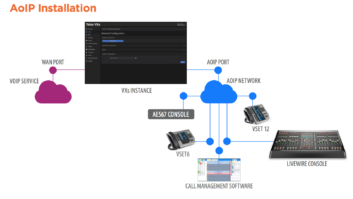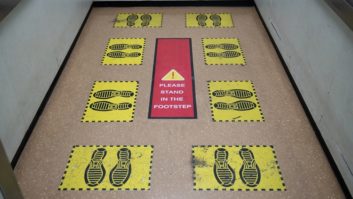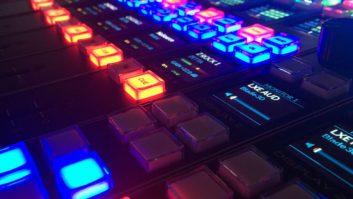The right choice in an On-air console
Feb 1, 2005 12:00 PM, By Chriss Scherer, editor
When you enter an on-air studio, what’s the first piece of equipment you usually notice? Most likely it’s the console. In many cases it’s the largest piece of equipment in the room, but even if it’s not, it is the center focus of the studio operation. The various sources used at a station are all vital players in program creation, but the console is the center of control.

Most facilities house at least two studios, so it makes sense for the console used in each studio to be identical or at least share common components and operational characteristics. In a larger facility, the commonality not only reduces the spare parts inventory, it provides built-in redundancy and eases the transition for uses between studios.
The choices for an on-air console are many. The decision was previously based on physical size first, with consideration for a handful of options. Today the choices are analog or digital, and stand-alone or router-based. Physical size is still relevant, but features and use are the key decision elements. And while the dividing lines between categories sound clear, there are some designs that blur the division between stand-alone and router-based.
Legacy or leading-edge?
If an analog console is your choice, the router integration aspect is not a critical consideration. Analog consoles can be configured to work with a router, but the router is not necessarily a key component to the operation. Overall, analog consoles provide solid performance with proven technology.
Because of the discrete wiring installation, analog consoles can be part of a system that is easier to understand than digital designs. Input and output changes are made with physical components, although a refined wiring plan can facilitate these changes when they are necessary. An analog console may also be more forgiving of less reliable power.
The discrete console approach is still a viable option in some facilities. Recent Facility Showcase features in Radio magazine have highlighted some of these uses. This approach is more common in small to medium facilities.
Once a tool for the privileged few, digital consoles have grown in popularity and in available choices, while the cost of these consoles has continued to fall. Many digital console manufacturers offer products that are priced competitively with analog designs.
Digital consoles can be stand-alone systems or part of a router-based audio network. Because of the digital signaling, some are able to function in both environments, blurring the line between stand-alone and router-based. Digital consoles offer enhanced features and optimum audio performance.
The latest trend in router-based systems has completely changed the personality of the digital console. In fact, the device in the control room may not even be a console at all, but rather a control surface that communicated with a centrally located routing and mixing mainframe. The control surface has no audio in it. It functions like a fancy keyboard on a computer. The marriage of control surface and router has reached a peak in design efficiency.
The control surface takes the function of a routing controller to provide a way of selecting an audio source and destination, and then adds the ability to alter audio levels. The work is done in the mainframe, which may also apply equalization or dynamics control.
By connecting all the sources and destinations to a central mainframe, the need to route discrete audio paths is reduced. Instead of multiple pairs of audio and control wiring between studios and a technical operations center (TOC), a few runs of cable can provide the needed connectivity.
This central wiring plan makes sense when an automation system, a satellite receiver and codecs are all located in the TOC, but when audio sources must be located in a studio, the need to run separate audio paths may still exist. There are two approaches to reducing this discrete wiring need.
Both use the idea of placing an audio frame in the studio. One approach is a rack-mounted frame that can be a regular audio mainframe or a scaled-down version. The other approach relies on the console having audio capabilities built in, so that audio is connected to the console directly. Either way, the connected audio, such as a mic preamp or tabletop audio editor, is made available to the audio network. It can then be routed and recalled to any available output in the facility.
Display and control
While not unique to consoles in general, the use of LEDs to illuminate displays has seen an increase in popularity. The variety of colors and intensity of LEDs provide the appropriate aesthetics, but the long lifespan of LEDs makes them attractive for maintenance.
Even stand-alone consoles can benefit from their use. A console that uses incandescent lamps can usually be fitted with LED replacements. The initial cost for the LEDs will be greater than a box of bulbs, but the annoyance of constantly replacing lamps will end. In the end, the cost of the LED over its lifespan will at least equal the same cost of the necessary lamps to cover the same period.
Router-based consoles provide a simple way to identify selected sources, typically with read-outs on each channel. Likewise, there can be read-outs for master sections. A console’s status can easily be determined with a glance.
While audio meters are an annoyance (if they are noticed at all) to most announcers, console meters have evolved as well. You can still see mechanical VU meters on many systems, but digital displays are taking over, whether as an LED-based meter display or an on-screen meter. The on-screen console display can also include a clock and event counter. Some console designs use the display to indicate configuration status as well.
One additional feature of digital consoles is their use of soft keys. By dynamically changing the function of buttons, commonly used tasks can be assigned to fixed keys, while less frequent assignments can be provided on assignable keys.
The cost of a digital console and router system may seem to be significantly more than stand-alone consoles, but the addition of a router and probable reduction in wiring will likely make the cost comparison less diverse. The final decision on which method to implement is affected by the long- and short-term needs, the potential upgrade needs, and the ability to implement needed changes.
Resource Guide
A sample of available on-air consoles

There are eight digital consoles in the Studer On Air series. The On Air 500 has six channel faders and two master faders. It can operate on ac power or 24Vdc for remote use. The On Air 500 Modulo separates the fader, master and meter sections for discrete mounting. It can also accept a second six-fader module. The On Air 1000 is based on the On Air 2000, and offers 10 channel faders and two master faders. Settings can be saved and recalled for each operator. The On Air 2000M2 is the successor to the company’s first digital radio console, the 2000. It features six-channel mixer sections and a master module. One to four mixer sections can be attached. The On Air 2000M2 Modulo allows the components to be separated for discrete mounting. The On Air 3000 and On Air 3000 Modulo use color TFT screens and six-channel modules to create a mixing surface. As many as eight fader modules can used. Additional modules provide extended control. The On Air 5000 is based on the company’s D941 console and supports 32 faders in I blocks of four-channel fader panels. All the consoles feature an integrated audio routing system. The 500 includes Lexicon effects processing. All other models include dynamics and effects processing.
www.studer.ch

Audioarts offers three digital consoles in its line as well as the ADR-32 router. The modular D-75 comes with four stereo busses, dual domain outputs, sample rate conversion on all digital inputs, and interchangeable input module daughter cards for easy analog-to-digital field switches. It is available in a 13- or 21-input frame. New LED meter displays add to the functionality of the D-75 meterbridge with full-scale digital peak plus VU metering. All switching features LED illumination and an automatic timer, built-in machine interface and clock all come standard.
The R-55e expands the feature set of its predecessor and has illuminated LED switches and a flip-up meterbridge that provides direct access to the I/O connectors and logic programming dipswitches. The low-profile, modular console features two stereo program busses, two mono busses, optional telephone caller input and opto-isolated logic control with built-in machine interface.
The D-16 combines the function of a router into the console by routing input to any fader or to any monitor feed. Inputs are shown in bright LED dot-matrix displays above the faders and monitor controls. It features two analog and digital stereo outputs, two mono analog outputs, four mix-minus outputs, 14 input faders plus two caller faders; four mic preamps and complete monitoring.
www.wheatstone.com

Autogram offers three analog console lines. The Mini-mix 8A and 12A are eight- and 12-fader mixers with 12 and 25 inputs respectively. Each features two dedicated mic inputs and a mix of balanced and unbalanced inputs with VCA control and LED level meters in a tabletop package. The Pacemaker 618, 648, 828 and 1032 offer multiple inputs in a compact space. The model number describes the configuration of control faders and stereo inputs (i.e. six faders and 18 stereo inputs). Each includes eight patchable mic preamps. The PM218 and PM228 are modular designs that can hold 18 or 28 hot-swappable modules. As many as eight mic preamps can be patched as needed. All the consoles feature a tabletop design with multiple output busses and P&G faders. The Pacemaker and PM series provide a mix-minus bus.
www.autogramcorp.com

LPB offers the MX series in several frame sizes and input configurations. All feature dual stereo output busses and two mono outputs, which are ideal for mix-minus feeds. The MXA-4, MXA-5 and MXA-6 are the most compact of the line and feature slide faders. The MX consoles range from six to 18 modules with slide or rotary faders and standard or narrow module configurations. The console modules contain all the electronics. No active components are mounted on the motherboard or frame. Faders control VCAs for quiet operation. All consoles are available as tabletop (standard) or drop in.
www.lpbinc.com

Klotz offers a console/router system based on the Vadis audio engine. Available in two frame sizes, the 880 and the smaller 210, both provide I/O and control of any source connected to it. The 880 frame holds 21 modules, and multiple frames can be linked to create an audio network. The Vadis DC II attaches to the Vadis audio network and provides console surfaces from four to 24 faders. The Paradigm is a stand-alone digital console that provides an eight- or 16-fader surface.
New to the Klotz line is Aeon. This flat-panel console features a modular control surface and graphic configuration software that allows individual users to configure the system. Available in eight-, 12- and 16-fader surfaces, each four-fader module is in its own housing. The Monitor-DSP-Master Control Module offers access to DSP functions via rotary encoders and large displays. It comprises central bus assignment, 20 assignable push-buttons for monitor sources and 10 assignable function buttons. The Aeon can stand-alone or connect to a Vadis network.
www.klotzdigital.com

The Axia Audio system conveys audio and peripheral data streams over standard Ethernet hardware and cable, reducing infrastructure costs. A CAT-5 or fiber conveys multiple audio channels, control, program-associated-data, VoIP telephone and computer data. A 100Base-T link can carry 50 bidirectional stereo channels of 48kHz, 24-bit linear PCM audio. A variety of audio terminals, called Nodes, can be distributed around the network to provide audio routing and control. Mixing functions are controlled with the Smart Surface, a console control surface that provides a familiar console controller for adjusting levels and assigning inputs and outputs.
www.axiaaudio.com

Available in six, 12, 18 and 24 channel sizes, Radio Systems Millenium consoles feature three output busses, remote control and metering, a comprehensive monitor section with standard eight position selector, and a clock/timer. Models differ only in their channel count and meter complement of three, five or seven meters. The 18- and 24-channel units also feature an auxiliary cutout for an extra meter or clock/timer. The soft-touch rubber keypads are illuminated by LEDs. The clock/timer connects to the Radio Systems CT-6. The Millenium Digital provides AES/EBU I/O, 10 mix-minus busses and a serial interface for third-party equipment. Radio Systems RS and Millenium consoles can be upgraded to digital versions.
www.radiosystems.com

Wheatstone consoles have always provided flexibility by supplying multiple program and mix-minus outputs. Wheatstone offers two choices in analog consoles. The A-7000 features four stereo outputs, two mono outputs and four mix-minus busses. Any module can be placed in any slot for greater flexibility. The A-5000 is an analog console that can be converted to digital in the field. The digital choices include seven different models, most of which are modular. The D-4000 features four stereo mix busses, six VU meters and four mix-minus outputs. The D-8000 can integrate with the Bridge router for greater flexibility. The Generation 3, Generation 4, Generation 5, Generation 8 and Generation 9 control surfaces fully integrate with the Bridge router to provide several accessible features from the control surfaces. A system can be designed with multiple output busses, mix minuses and sends. The G5 through G9 versions provide multiple color displays on the meter bridge for output level display, input channel displays and other information.
www.wheatstone.com

All Logitek consoles are built around the Digital Audio Engine platform, which combines routing, switching and console functions into one mainframe unit. Usually two console control surfaces can be connected to one Engine, depending on the number of audio inputs needed for each. Multiple Audio Engines can be linked to provide additional I/O and routing. Two control surfaces, the Numix and the Remora, are available. Both come pre-configured with four stereo mix busses, one cue channel, 24 clean-feed mix-minus outputs and a three channel sub-mixer. Special functions can be assigned with the Configuration Command Library. Logitek will unveil the Mosaic console series at NAB2005.
www.logitekaudio.com

Arrakis offers four consoles. The Revolution is modular console in three frame sizes. It includes a separate I/O frame that accepts analog or digital sources, and it can be controlled by a console surface or a PC to create a virtual console. The engine also provides two serial connections for external control including a virtual talk host turret with a PC monitor. The 12,000 series modular analog consoles are available in three frame sizes (8, 18 and 28 modules) and feature VCA level control and dc logic switching. Four input modules are available. The 1200 series analog consoles provide five, 10 or 15 channels to support 10, 20 or 25 inputs respectively. The Nova-10 console accepts consumer audio sources through its RCA jacks on the rear panel. All Arrakis consoles feature P&G faders.
www.arrakis-systems.com

The Harris Vistamax is a networkable audio management system that can start with a single BMX Digital or Vistamax-enabled console and expand from there. A variety of system cards provide flexible configurations. The RMX Digital, BMX Digital and VSDM consoles can operate as stand-alone consoles or fully integrate into the Vistamax system. All three have modular designs. The RMX Digital features four program busses, four telco/codec inputs with mix-minus and dual stereo meters. The BMX Digital features four program busses, four utility buses, two send buses, telco/codec inputs with mix-minus and five stereo meters.
The Legacy is a stand-alone digital console with four program buses, a stereo send bus, selectable off-line mix, four telco/codec input modules, three stereo bar graph meters and a digital clock and timer.
The Airwave is available in two modular versions: analog and digital. The Airwave digital accepts analog or digital sources by changing an input configuration card. The Impulse is a modular, digital console that can also accept analog or digital inputs.
www.broadcast.harris.com

The Rubicon is a modular mixing control surface that integrates with the SAS 32KD Digital Audio Network for mixing, switching, level control and effects. The surface is modular, customizable and fully programmable. Frame sizes are available from eight to 40 modules. The 32KD can route 512 signals in a 6RU frame. Additional frames can be linked via fiber optic connections. Additional inputs and outputs can be connected to the 32KD network with Riolink units to provide 32 input or output channels in studios and other locations away from the 32KD frame.
www.sasaudio.com

The AEQ BC 2000 Digital console and BC 2000D router provide a traditional radio console feel with a modular control surface. Motorized faders and are available on the mixer modules. The surface includes 32 programmable keys for integration with other equipment. Equalization, dynamics, delay and other DSP functions can be used. An AES 10 MADI module can be used to send grouped inputs and outputs via coax or fiber. The router can be used stand-alone or integrated with the console. The router can provide up to 2,048 inputs by 2,048 outputs. Intercom panels can be added to the system as well. Multiple router frames can be linked via MADI.
www.aeqbroadcast.com












